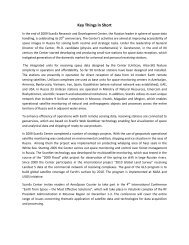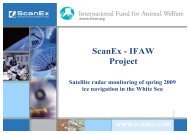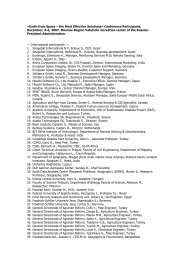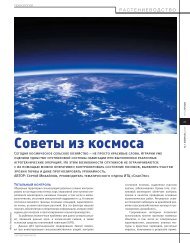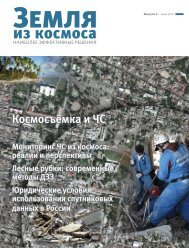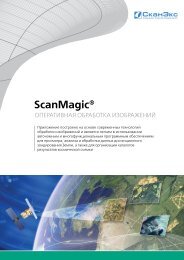RISAT-1. Radar Imaging Satellite
RISAT-1. Radar Imaging Satellite
RISAT-1. Radar Imaging Satellite
Create successful ePaper yourself
Turn your PDF publications into a flip-book with our unique Google optimized e-Paper software.
Spacecraft<br />
Characteristics<br />
<strong>Radar</strong> <strong>Imaging</strong> <strong>Satellite</strong><br />
<strong>RISAT</strong>-1 spacecraft mainframe<br />
bus is configured by deriving<br />
heritage from previous IRS missions<br />
as well as mission specific new subsystem<br />
designs. The prism shape of<br />
the satellite allows stowing of the<br />
active antenna in three folds around<br />
the prism structure. The prism<br />
structure is built around a central<br />
cylinder. Most of the spacecraft<br />
subsystems and the complete<br />
payload are integrated in the prism<br />
structure and the central cylinder.<br />
The solar panel and rest of the<br />
spacecraft subsystems are mounted<br />
on the cuboid portion of the<br />
satellite. Two solar panels with high<br />
efficiency multi-junction solar cell<br />
charge Ni-H2<br />
battery of 70 AH<br />
capacity. The satellite has an onboard<br />
recorder with storage<br />
capability of 240 Gbits of data. The<br />
on-board data transmitter can<br />
transmit with maximum data rate of<br />
640 Mbits/sec in X-band on two<br />
polarizations (RHC and LHC) by<br />
reuse of X-band carrier. In the nonoperating<br />
condition, the active<br />
antenna looks at nadir. Prior to<br />
operation, the spacecraft will be roll<br />
0<br />
tilted by ±34 to enable viewing<br />
either right or left side of the flight<br />
track. The satellite will also have<br />
yaw steering capability to minimize<br />
earth rotation effects.<br />
Attitude and Orbit Control<br />
System (AOCS) caters to various<br />
modes of SAR payload operation.<br />
The pointing accuracy requirement<br />
of <strong>RISAT</strong> is 0.05deg (3 σ); and<br />
-5<br />
attitude rate specification is 5x10<br />
deg/sec (3 σ) for frequencies<br />
-4<br />
0 - 0.2 Hz and 1x10 deg/sec (3 σ)<br />
for frequencies ≥ 2 Hz; and the<br />
post-facto attitude knowledge<br />
requirement is 0.02deg. One of the<br />
payload operating modes, namely<br />
'spot tracking' calls for imparting a<br />
large rate (around 0.42deg/sec)<br />
about pitch axis and imaging for a<br />
few seconds in the step and stare<br />
mode. The basic attitude reference<br />
during spot, strip, and ScanSAR<br />
modes of payload operation will be<br />
from gyros. For strip and ScanSAR<br />
modes, the updates will be from<br />
star sensors.<br />
The attitude sensors will include<br />
star sensors (18 deg.x18 deg.<br />
FOV), 4π<br />
sun sensors,<br />
magnetometers, Inertial Reference<br />
Unit (IRU) with DTGs, and conical<br />
earth sensors. The actuators will<br />
include RCS thrusters (eight 11N<br />
thrusters for attitude control and<br />
one 11N thruster for orbit control),<br />
eight 1N canted thrusters to<br />
produce control torques around all<br />
axes, and four 11N thrusters for<br />
orbit control with off-modulation<br />
capability); reaction wheels (0.3 NM<br />
and momentum storage capacity of<br />
50 NMs); and magnetic torquers of<br />
2<br />
60 Ampm capacity. A bus<br />
management unit (BMU) is<br />
designed around the MA31750<br />
processor which implements the<br />
MIL-STD –1750 architecture. The<br />
BMU interfaces with TTC (RF),<br />
sensors, power, thrusters, MTCs,<br />
DTG, WDE and payload for<br />
command and house keeping<br />
telemetry functions. It has MIL-<br />
STD-1553 interface with star sensor<br />
and SAR payload.




